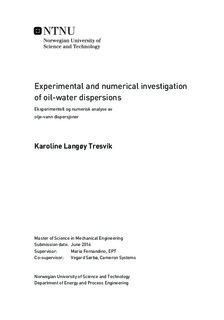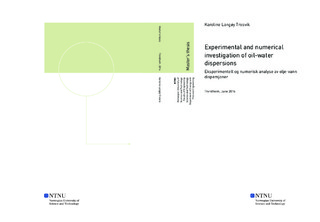| dc.description.abstract | Crude oil in the reservoir is accompanied by formation water. Separating water from
oil offshore before transporting it is necessary. This requires compact and robust separators. In order to optimize the design of separators, a good understanding of separation
mechanisms and crude oil behavior is essential. Testing separation with batch tests
compared to continuous flow tests is less time assuming and less expensive. This work
has been dedicated to gain knowledge about batch settling, through experimental and
numerical investigation. Separation experiments with Exxsol D60, water and Span 80
have been carried out. Testing with model oil instead of crude oil is beneficial. The
ultimate goal is to simulate crude oil and water emulsions using a model fluid systems.
Numerical simulations of mixing performance were performed as an optimization study
before batch testing. They showed that both rotation and the presence of static baffles
improve the mixing significantly. The experimental batch tests was performed with different
concentrations of Span 80, different water cuts and different rotations. The result
showed that Span 80 can be used as a surfactant to stabilize model oil. Investigation
of what affects the stability the most was done. Rotation proved to have the greatest
effect. Span 80 concentrations of 0.05-0.2 vol.% showed small changes on the stability.
It is suspected that these concentrations are too high, and that Span 80 should be estimated
with respect to oil volume instead of total volume. Polderman s model was used
to connect batch data with flowing systems. Fluxes based on the batch result were plotted,
and showed promising result which indicates that model oil can be used to simulate
crude oil. Experiments with the same fluid system were performed in a flowing rig. The
purpose was to investigate if these tests provided the same stability result. This resulted
in a stable emulsion, which prevented further flow tests. This may be because of a too
high Span 80 concentration. | |

